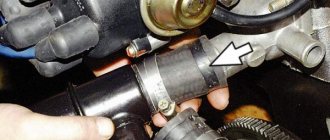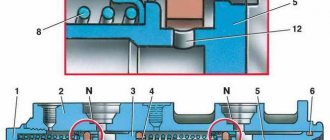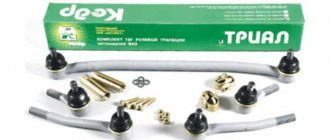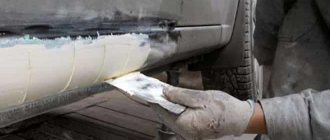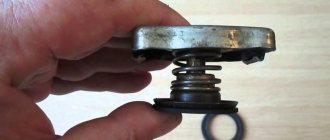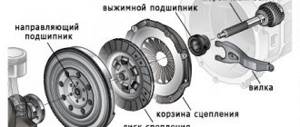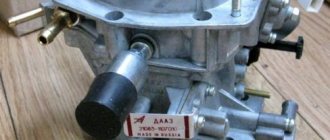The operation of the thermostat is based on switching the circulation modes of the vehicle's coolant in a large or small circle. Distillation in a small circle warms up the engine soon after it starts, and when the antifreeze reaches the extreme temperature mark (85-90 degrees), a special valve opens, directing the liquid into a large circle and allowing it to cool. Replacing the VAZ 2107 thermostat may be necessary in case of interruptions during operation, leading to prolonged warm-up of the engine or its accelerated boiling.
Thermostat Specifications
The cylindrical thermostat is equipped with three outlets for pipes - from the engine, from the radiator and to the circulation pump. You can get acquainted with the design in more detail by looking at the cross-section of the thermostat:
Thermostat VAZ 2107 cross-section
When the engine starts, coolant flows through the cylinder block and pump, once above 80 degrees is reached, the main valve shutter begins to allow antifreeze through the radiator. As the liquid temperature rises, the throughput of the valve increases, while at the same time the bypass valve closes the flow of antifreeze from the engine. The mark of 94 degrees is considered the maximum at which the liquid moves exclusively in a large circle (the main valve is open, the bypass valve is pressed tightly).
What kind of thermostat VAZ-2114
The efficiency of the stove and other parameters that affect the operation of the entire engine depend on the engine temperature. The temperature depends on the thermostat. A thermostat is a device that directs coolant through a large or small cooling circle.
- What is a thermostat?
- Engine cooling system diagram.
- Types of thermostats for VAZ.
- Injection thermostats.
- Which thermostat is better for VAZ 2114?
- Video.
A thermostat is a device that regulates temperature. Essentially, it is a shut-off and control device that opens, closes and changes the direction of flow of coolant. There are two cooling circuits in a car engine cooling system: large and small. The large circle is the circulation of fluid through the main radiator, and the small circle is the circulation of fluid bypassing the radiator.
The operation of the thermostat is regulated by a valve, which, depending on the temperature, opens one pipe and closes the second.
Features of checking the thermostat
Testing the thermostat can be done without special equipment. To determine the quality of the thermostat, you need to open the hood of the car and start the engine in a cool state. Within a few minutes, the radiator pipe should maintain its initial temperature; it can be determined tactilely by placing your hand on the hose. When the operating range of 80-90 C is reached, part of the device and the nozzle area will quickly heat up. It is this sequence that characterizes the proper operation of the thermostat. The operating temperature of the VAZ 2107 injection engine can reach 95 degrees in summer weather.
The main malfunctions of the thermostat leading to the need for thermostat replacement:
- the engine is “boiling”, the valve is stuck closed;
- the engine takes a long time to warm up, the valve is stuck open. In winter, this leads to weak heating and poor heating of the interior;
- The valve does not close or open completely. In the summer it will boil, and in the winter it will be difficult to warm up.
Before replacing, you can check the thermostat in one more way. In this case, take a pan, add water and bring to a boil. In a cold state, the thermostat bypasses through holes 1 and 3; if it is heated in boiling water, it will bypass through 3 and 6.
If there is a need to replace a part, then which thermostat is better for the VAZ 2107 , of course, everyone chooses from their own experience, but we can recommend some manufacturers. The preference of the majority is given to PRAMO - a Russian development with a Polish thermoelement due to accelerated heating and long service life. Also worthy of attention are the Chinese BAUTLER and the Polish WEEN, a good option from.
You can consult with car service workers who are familiar with the quality of their work. From practice, perhaps the worst is the Chelyabinsk one from.
Purpose of the device
The thermostat is located between the large and small circles of the engine cooling system. Structurally, the product has the form of a housing, inside of which there is a valve with a temperature-sensitive element. This valve switches the coolant flow in a small or large circle.
The coolant flow regulator is connected through pipes to the pump, engine and cooling radiator. At the moment the engine starts, when the antifreeze has not yet warmed up, the thermostat, or rather its valve, is in closed mode. The coolant circulates through a pump and passes only through the cylinder block. The liquid that is in the radiator does not take part in the cooling process of the engine, but until it heats up to 80-90 degrees.
It is important to know! The thermostat valve on the VAZ 2107 opens completely when the coolant temperature reaches 84-86 degrees.
When the set temperature is reached, the thermostat locking disc moves. As a result of the valve opening, liquid begins to circulate in a large circle, passing through the radiator. When fluid circulates through the radiator, the cooling efficiency of the engine increases. As soon as the temperature of the liquid decreases, the valve closes and circulation occurs in a small circle.
The coolant temperature indicators are affected by the following indicators:
- motor operating mode;
- movement speed;
- outside air temperature.
The thermostat maintains the coolant in a certain temperature range. This, in turn, affects the functioning of the motor, for which constant temperature indicators are important. In terms of design, all types of thermostats on the VAZ-2107 are practically no different. Structurally, they are a housing with a thermal valve located inside. The design of the device has three holes that serve to connect hoses from the cooling system.
Malfunctions and methods for identifying them
Such a simple mechanism as a thermostat has only three causes of possible malfunctions:
- The valve does not close, as a result of which the liquid constantly circulates in a small circle without passing through the radiator.
- The valve does not open completely, which reduces the cooling efficiency of the motor.
- The valve does not close. In this case, the antifreeze passes in a large circle through the radiator. This has a negative impact on the engine, as it does not reach the required operating temperature.
Before replacing a product, you need to make sure it is not working. Let's find out in more detail how to check the thermostat of a VAZ 2107. You can determine one of the above malfunctions in the following ways:
- If the valve is jammed and does not close, then after starting the engine you need to check whether the lower part of the radiator immediately heats up or not. If it happens right away, this indicates that the device is faulty.
- If the device is jammed and does not open, then the engine temperature will rise, which can lead to costly repairs.
- Valve wedging can be detected by the fact that the motor does not reach sufficient temperature for a long time.
How to change a thermostat
Before replacing the thermostat, check the rigidity of the pipes. The fact is that if these parts have been standing for a long time, they become rigid and crack at the most inopportune moment, so it is better to replace them in advance. To replace the thermostat on a VAZ 2107 you will need:
- new part;
Thermostat VAZ 2107
- Phillips screwdriver;
- antifreeze or antifreeze;
- if necessary, pipes, clamps and sealant.
The replacement process is not complicated and can be done independently. Dismantling is carried out both with the help of an inspection hole and without it. Depending on the type of engine, carburetor or injection, the necessary stages of work are selected. Installing the latter is somewhat more complicated and requires additional tools.
The coolant is drained from the engine, the latter must cool completely after previous operation. For convenient operation, remove the battery. The heater tap is opened and the radiator filler cap is removed. After preliminary installation of the container, the drain of the cylinder block and radiator opens. Next, you need to remove the old clamps and carefully release the thermostat from the pipes.
For reliability, lubricate the pipes with sealant. After stable fixation of the working part, it is securely secured with clamps, and the battery is also returned to its original place. If the pipes are unsuitable, they can also be replaced with new ones. Next, add antifreeze and test the thermostat using the above method or using a pyrometer.
All about the thermostat VAZ-2107
This article is for those who want to thoroughly understand how the thermostat of the VAZ “classic” works and works, how to determine the malfunctions of this device, select the right spare part and perform a replacement. It is the thermostat that is to blame for the fact that in winter the cabin is cold and the engine takes a long time to warm up. It is also the most common cause of engine overheating.
What's inside the thermostat
The classic thermostat housing was originally made of brass. Then, different factories at different times produced thermostats with housings made of aluminum alloy and steel. During assembly, a block of two assembled valves is placed inside the two halves of the housing. Then it all gets rolled up and becomes inseparable. The valve block is assembled inside the holder. The rod is fixed motionless. The main and bypass valves can move relative to it, overcoming the force of the springs. On the outside, the housing has three pipes for connection to the water pump (pump), engine and radiator.
1. Inlet pipe (from the engine). 2. Bypass valve. 3. Bypass valve spring. 4. Glass. 5. Rubber insert. 6. Outlet pipe. 7. Main valve spring. 8. Main valve seat. 9. Main valve. 10. Holder. 11. Adjusting nut. 12. Piston. 13. Inlet pipe from the radiator. 14. Filler. 15. Clip. D - fluid inlet from the engine. R - fluid inlet from the radiator. H - liquid outlet to the pump (pump).
How does the VAZ-2101-2107 thermostat work?
After starting a cold engine, antifreeze begins to be pumped through the thermostat housing from the engine to the pump, through the upper and middle pipes. The main valve is closed and does not allow fluid into the radiator, and the bypass valve is open. The engine warms up and the coolant temperature rises. Gradually, heat is transferred to a special filler, which, pushing away from a stationary piston, lifts the valves up (as shown in the picture). The filler and piston must be adjusted so that the opening of the main valve begins at a temperature of 81 degrees C with a tolerance of +4 - +5 degrees (note - only a plus!). The liquid begins to circulate through the radiator and cool, but some of it still passes directly to the pump. Next, the valve rises 6 mm and, at the end of the stroke, closes the bypass valve. If it is not closed, the antifreeze will spin in a “small circle” - pump-motor-thermostat-pump, and this will lead to overheating. The liquid pumped through the radiator quickly cools itself and cools the filler in the thermostat. It compresses, the valves move down with a spring, opening the bypass valve and closing the main valve. This process is continuously repeated, maintaining the engine temperature between 87 and 92 degrees. This is how the thermostat of a car that has recently rolled off the production line works. You don’t need any cardboard, but you will only have to insulate the “face” in frosts below 40!
Malfunctions of the VAZ-2107 thermostat, checking operation
Nothing is eternal under the Moon! And the thermostat gets tired over time. The properties of the filler change, the rubber of the valves becomes dull, and the springs lose their elasticity. We notice that the VAZ-2107 takes a long time to warm up, and in cold weather the temperature gauge needle barely reaches the edge of the green sector. This malfunction can progress and, over time, the temperature will end up in the middle of the white sector of the scale. You can check the operation of the thermostat without removing it from the engine. This is done like this: start the cold engine and feel the lower pipe near the thermostat with your hand. It should not become warm until the temperature indicator needle reaches a point 3-4 mm from the red zone of the scale. If the heat is felt earlier, the thermostat is not fully operational. The second malfunction is engine overheating due to a stuck thermostat. Here everything looks like this - the engine is hot, but the radiator and its pipes are cold. A thermostat with a stuck valve needs to be replaced urgently. If a malfunction occurs far from civilization, you can pick out the main valve and drive to the repair site. There is no need to remove both valves; the engine will overheat, because the “small circle” is not closed.
We select a replacement for a faulty VAZ-2107 thermostat
Is it worth changing it? If the thermostat is stuck, then it is not discussed, of course, changing it. But if it’s underheating, then it’s worth thinking about. The fact is that today it is very difficult to buy a normal thermostat that meets all the parameters. They all work, they open, but too early, or the spring is weak. And, having installed such a product, we get a coolant temperature of 75-80 degrees. This corresponds to the end of the white sector of the temperature indicator. So, if your thermostat does not heat up within such limits, then you should not change it. The exception is when you know for sure that you bought a quality spare part. When purchasing a thermostat, quality can only be assessed approximately. To do this, we inspect the case, packaging, and markings. The assembly must be neat, the coloring must be even and of high quality. Markings must be present - who the manufacturer is, brand and temperature. “Classic” thermostats are designed for a temperature of 82 degrees - this is the beginning of the valve opening. I came across markings of 80 degrees, 83 degrees. There are rumors that there are 90-degree devices on sale, but I have never seen such devices.
Thermostat with steel housing, painted
Thermostat with aluminum alloy body
After an external inspection, try blowing air into the lower pipe. If air passes through, the valve is leaking, take another copy. At home, before you start replacing, give the purchased device one more check. Place it in a suitable pan, fill it with water and place it on the stove. When the water almost boils, carefully, so as not to get burned, remove the thermostat and try to pour water from the tap into the middle pipe. It should flow freely into the lower pipe. The flowing water will cool the filler, and the valve will close again, and water will flow from the upper pipe. If everything is so, then your thermostat is working properly and can be installed on the car.
Replacing the thermostat
In addition to the thermostat itself, we may need new pipes, clamps, and antifreeze. The total capacity of the VAZ-2107 cooling system is 9.85 liters. It is better to use worm clamps; choose thicker ones. It is better to replace the pipes, since the old ones are already hardened and may leak during installation. The procedure is as follows: 1. Disconnect the terminals and remove the battery. 2. Drain the antifreeze through the radiator and block drain plugs; you can simply remove the lower radiator pipe. Place a basin under the car. 3. Loosen the clamps on the engine, pump and radiator. 4. Remove the thermostat along with the pipes. 5. We install new pipes on the new thermostat and tighten them with clamps. 6. Place the assembled unit in place and tighten the clamps. 7. Close all open plugs and fill in fresh antifreeze. 8. Start and warm up the engine until the thermostat opens, add antifreeze. If there is any air left, we raise the front of the car on a suitable hill and run the engine with the radiator cap open for several minutes at 2000 - 3000 rpm. Usually this is enough. 9. Add antifreeze to the radiator and expansion tank, close the plugs tightly. There are a lot of questions about sealant - do I need to coat the places where the pipes fit? If the pipes are soft and the clamps are good, then sealant is not needed.
